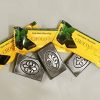All fish can be classified into two very broad categories: fish and shellfish. In the most basic terms, fish have fins, backbones, and gills, while shellfish have shells of one form or another.
Fish are divided into two groups, freshwater and saltwater. Because salt water provides more buoyancy than fresh water, saltwater fish, such as cod, flounder, and tuna, have thicker bones. Freshwater fish, like catfish, perch and trout, have a light skeletal framework with lots of minuscule bones.
Fish can also be classified as flatfish and roundfish. Flatfish are shaped like an oval platter, the top side being dard and the bottom light in color. Both eyes are on the dark side of the body. Flounder, halibut, and true sole are all flatfish. Roundfish, such as grouper, rockfish, and salmon, have a rounder body, with eyes on both sides of the head.
Further, fish are divided into three categories based on fat content - lean, moderate-fat and high-fat.
- Lean - The oil in lean fish is concentrated in the liver, rather than being distributed throughout the flesh. The fat content of lean fish is less than 2-1/2 percent and the flesh is mild and lightly colored. Fish in the lean category include black sea bass, brook trout, cod, croaker, flounder, haddock, hake, halibut, pollock, ocean perch, red snapper, rock fish, smelts, and tilefish.
- Moderate-fat fish usually have less than 5 to 10 percent fat and include bluefish, striped bass, sturgeon, swordfish, tuna, and whiting.
- High-fat
fish are those with more than 10 percent fat content. Some of the more
popular high-fat fish are herring, butterfish, mackerel, rainbow trout,
king salmon, shad, and yellowtail. The more even distribution of fat in
moderate and high-fat fish gives their flesh a darker color, firmer texture,
and more distinctive color.
Shellfish is a broad term for all aquatic animals that have a shell of some kind, whether crustaceans or mollusks. Crustaceans have elongated bodies and jointed, soft, crustlike shells. Crustaceans include crabs, crayfish, lobster, and shrimp.
Mollusks are invertebrates with soft bodies covered by a shell of one or more pieces. They're divided into three groups.
- Gastropods all have a single shell and a single muscle. Gastropods include abalone, limpet, periwinkle, snail, and whelk.
- Bivalves are soft-bodied mollusks that have two shells hinged together by a strong muscle. Bivalves include clams, mussels, oysters, and scallops.
- Cephalopods have tentacles attached to the head, and ink sacs, which serve to evade predators. The most common cephalopods are octopus, squid, and cuttlefish.
Cooking Smart by Sharon Tyler Herbst








